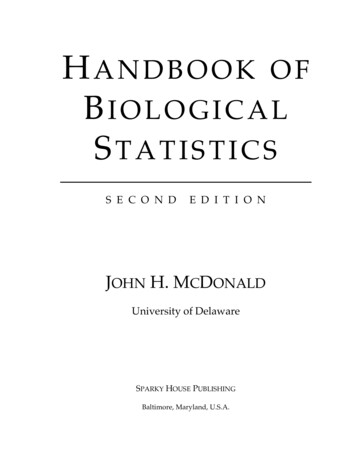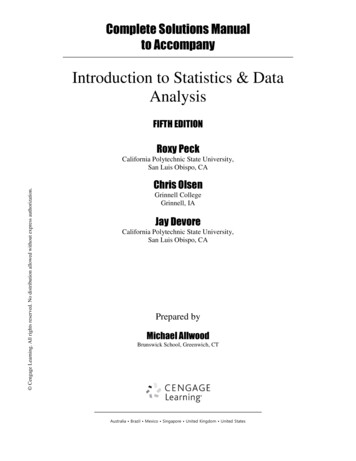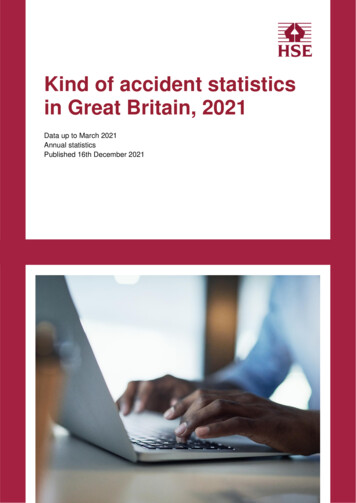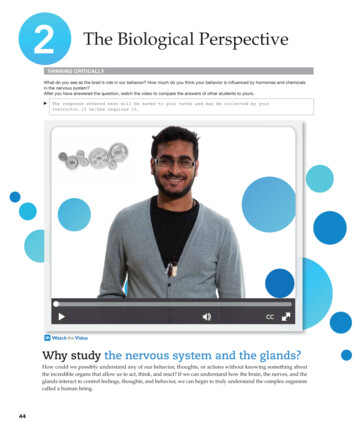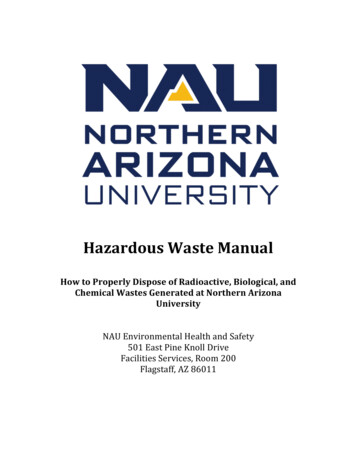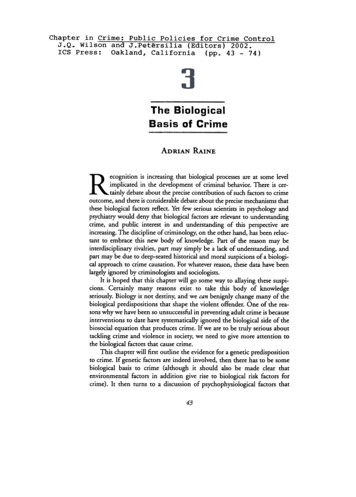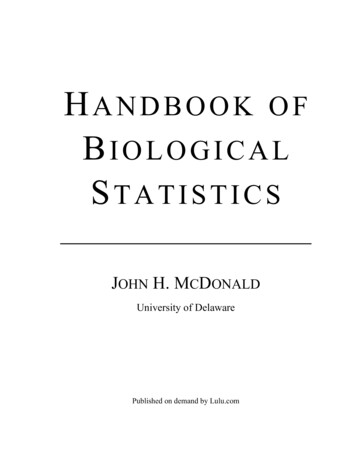
Transcription
HANDBOOK OFBIOLOGICALSTATISTICSJOHN H. MCDONALDUniversity of DelawarePublished on demand by Lulu.com
2008 by John H. McDonaldNon-commercial reproduction of this content, with attribution, is permitted; for-profitreproduction without permission is prohibited. See http://udel.edu/ mcdonald/statpermissions.html for details.
ContentsContentsBasicsIntroduction. 1Data analysis steps . 3Kinds of biological variables . 6Probability. 11Hypothesis testing. 13Random sampling . 18Tests for nominal variablesExact binomial test. 21Power analysis . 29Chi-square test of goodness-of-fit. 34G-test of goodness-of-fit . 41Randomization test of goodness-of-fit. 47Chi-square test of independence . 52G-test of independence . 58Fisher's exact test . 64Randomization test of independence . 69Small numbers in chi-square and G-tests. 73Repeated G-tests of goodness-of-fit. 77Cochran-Mantel-Haenszel test. 81Descriptive statisticsCentral tendency . 88Dispersion . 95Standard error. 99Confidence limits . 104Tests for one measurement variableStudent's t-test . 110Introduction to one-way anova . 115i
Handbook of Biological StatisticsModel I vs. Model II anova. 119Testing homogeneity of means . 122Planned comparisons among means . 128Unplanned comparisons among means. 132Estimating added variance components. 137Normality . 141Homoscedasticity. 145Data transformations. 148Kruskal-Wallis test. 153Nested anova. 161Two-way anova. 169Paired t-test . 176Wilcoxon signed-rank test . 181Sign test. 185Tests for multiple measurement variablesLinear regression and correlation. 190Spearman rank correlation . 202Polynomial regression. 205Analysis of covariance. 211Multiple regression . 217Logistic regression . 224Multiple testsMultiple comparisons. 233Meta-analysis . 237MiscellanyUsing spreadsheets for statistics . 242Displaying results in graphs: Excel. 250Displaying results in graphs: Calc . 261Displaying results in tables . 271Introduction to SAS . 274Choosing the right test . 282ii
IntroductionIntroductionWelcome to the Handbook of Biological Statistics! This handbook evolved from a setof notes for my Biological Data Analysis class at the University of Delaware. My maingoal in that class is to teach biology students how to choose the appropriate statistical testfor a particular experiment, then apply that test and interpret the results. I spend relativelylittle time on the mathematical basis of the tests; for most biologists, statistics is just auseful tool, like a microscope, and knowing the detailed mathematical basis of a statisticaltest is as unimportant to most biologists as knowing which kinds of glass were used tomake a microscope lens. Biologists in very statistics-intensive fields, such as ecology,epidemiology, and systematics, may find this handbook to be a bit superficial for theirneeds, just as a microscopist using the latest techniques in 4-D, 3-photon confocalmicroscopy needs to know more about their microscope than someone who's just countingthe hairs on a fly's back.The online version of this handbook is available at http://udel.edu/ mcdonald/statintro.html. If you want additional printed copy of the whole handbook, you can buy onefrom Lulu.com. I've used this print-on-demand service as a convenience to you, not as amoney-making scheme, so don't feel obligated to buy one. You can also download a freepdf of the entire handbook from that link and print it yourself.I have written a spreadsheet to perform almost every statistical test; they're linked fromthe online handbook, and the urls are printed here. Each comes with sample data alreadyentered; just download the program, replace the sample data with your data, and you'll haveyour answer. The spreadsheets were written for Excel, but they should also work using thefree program Calc, part of the OpenOffice.org (http://www.openoffice.org/) suite ofprograms. If you're using OpenOffice.org, some of the graphs may need re-formatting, andyou may need to re-set the number of decimal places for some numbers. Let me know ifyou have a problem using one of the spreadsheets, and I'll try to fix it.I've also linked to a web page for each test wherever possible. I found most of theseweb pages using John Pezzullo's excellent list of Interactive Statistical Calculation Pages(http://StatPages.org) , which is a good place to look for information about tests that are notdiscussed in this handbook.There are instructions for performing each statistical test in SAS, as well. It's not aseasy to use as the spreadsheets or web pages, but if you're going to be doing a lot ofadvanced statistics, you're going to have to learn SAS or a similar program sooner or later.1
Handbook of Biological StatisticsI am constantly trying to improve this textbook. If you find errors or have suggestionsfor improvement, please e-mail me at mcdonald@udel.edu. If you have statistical questionsabout your research, I'll be glad to try to answer them. However, I must warn you that I'mnot an expert in statistics, so if you're asking about something that goes far beyond what'sin this textbook, I may not be able to help you. And please don't ask me for help with yourstatistics homework (unless you're in my class, of course!).Further readingThere are lots of statistics textbooks, but most are too elementary to use as a seriousreference, too math-obsessed, or not biological enough. The two books I use the most, andsee cited most often in the biological literature, are Sokal and Rohlf (1995) and Zar (1999).They cover most of the same topics, at a similar level, and either would serve you wellwhen you want more detail than I provide in this handbook. I've provided references to theappropriate pages in both books on most of these web pages.There are a number of online statistics manuals linked at StatPages.org. If you'reinterested in business statistics, time-series analysis, or other topics that I don't cover here,that's an excellent place to start. Wikipedia has some good articles on statistical topics,while others are either short and sketchy, or overly technical.Sokal, R.R., and F.J. Rohlf. 1995. Biometry: The principles and practice of statistics inbiological research. 3rd edition. W.H. Freeman, New York.Zar, J.H. 1999. Biostatistical analysis. 4th edition. Prentice Hall, Upper Saddle River, NJ.2
Step-by-step analysis of biological dataStep-by-step analysis ofbiological dataI find that a systematic, step-by-step approach is the best way to analyze biologicaldata. The statistical analysis of a biological experiment may be broken down into thefollowing steps:1. Specify the biological question to be answered.2. Put the question in the form of a biological null hypothesis and alternatehypothesis.3. Put the question in the form of a statistical null hypothesis and alternatehypothesis.4. Determine which variables are relevant to the question.5. Determine what kind of variable each one is.6. Based on the number of variables, the kind of variables, the expected fit to theparametric assumptions, and the hypothesis to be tested, choose the best statisticaltest to use.7. Do the experiment.8. Examine the data to see if it meets the assumptions of the statistical test you chose(normality, homoscedasticity, etc.). If it doesn't, choose a more appropriate test.9. Apply the chosen statistical test, and interpret the result.10. Communicate your results effectively, usually with a graph or table.Here's an example of how this works. Verrelli and Eanes (2001) measured glycogencontent in Drosophila melanogaster individuals. The flies were polymorphic at the geneticlocus that codes for the enzyme phosphoglucomutase (PGM). At site 52 in the PGMprotein sequence, flies had either a valine or an alanine. At site 484, they had either a valineor a leucine. All four combinations of amino acids (V-V, V-L, A-V, A-L) were present.1. One biological question is "Do the amino acid polymorphisms at the Pgm locushave an effect on glycogen content?" The biological question is usually somethingabout biological processes, usually in the form "Does X cause Y?"2. The biological null hypothesis is "Different amino acid sequences do not affect thebiochemical properties of PGM, so glycogen content is not affected by PGMsequence." The biological alternative hypothesis is "Different amino acid3
Handbook of Biological Statistics3.4.5.6.7.8.9.10.4sequences do affect the biochemical properties of PGM, so glycogen content isaffected by PGM sequence."The statistical null hypothesis is "Flies with different sequences of the PGMenzyme have the same average glycogen content." The alternate hypothesis is"Flies with different sequences of PGM have different average glycogen contents."While the biological null and alternative hypotheses are about biological processes,the statistical null and alternative hypotheses are all about the numbers; in thiscase, the glycogen contents are either the same or different.The two relevant variables are glycogen content and PGM sequence. Othervariables that might be important, such as the age of the flies, are either controlled(flies of all the same age are used) or randomized (flies of each PGM sequence aredrawn randomly from a range of ages, so there is no consistent difference in agebetween the PGM sequences).Glycogen content is a measurement variable, something that is recorded as anumber that could have many possible values. The sequence of PGM that a fly has(V-V, V-L, A-V or A-L) is a nominal variable, something with a small number ofpossible values (four, in this case) that is usually recorded as a word.Because the goal is to compare the means of one measurement variable amonggroups classified by one nominal variable, and there are more than two classes, theappropriate statistical test is a Model I one-way anova.The experiment was done: glycogen content was measured in flies with differentPGM sequences.The anova assumes that the measurement variable, glycogen content, is normal(the distribution fits the bell-shaped normal curve) and homoscedastic (thevariances in glycogen content of the different PGM sequences are equal), andinspecting histograms of the data shows that the data fit these assumptions. If thedata hadn't met the assumptions of anova, the Kruskal–Wallis test would have beenbetter.The one-way anova is done, using a spreadsheet, web page, or computer program,and the result of the anova is a P-value less than 0.05. The interpretation is thatflies with some PGM sequences have different average glycogen content than flieswith other sequences of PGM.The results could be summarized in a table, but a more effective way tocommunicate them is with a graph:
Step-by-step analysis of biological dataGlycogen content in Drosophila melanogaster. Each barrepresents the mean glycogen content (in micrograms per fly) of12 flies with the indicated PGM haplotype. Narrow barsrepresent /-2 standard errors of the mean.ReferenceVerrelli, B.C., and W.F. Eanes. 2001. The functional impact of PGM amino acidpolymorphism on glycogen content in Drosophila melanogaster. Genetics 159:201-210. (Note that for the purposes of this web page, I've used a different statisticaltest than Verrelli and Eanes did. They were interested in interactions among theindividual amino acid polymorphisms, so they used a two-way anova.)5
Handbook of Biological StatisticsTypes of variablesOne of the first steps in deciding which statistical test to use is determining what kindsof variables you have. When you know what the relevant variables are, what kind ofvariables they are, and what your null and alternative hypotheses are, it's usually prettyobvious which test you should use. For our purposes, it's important to classify variablesinto three types: measurement variables, nominal variables, and ranked variables.Similar experiments, with similar null and alternative hypotheses, will be analyzedcompletely differently depending on which of these three variable types are involved. Forexample, let's say you've measured variable X in a sample of 56 male and 67 femaleisopods (Armadillidium vulgare, commonly known as pillbugs or roly-polies), and yournull hypothesis is "Male and female A. vulgare have the same values of variable X." Ifvariable X is width of the head in millimeters, it's a measurement variable, and you'danalyze it with a t-test or a Model I one-way analysis of variance (anova). If variable X is agenotype (such as AA, Aa, or aa), it's a nominal variable, and you'd compare the genotypefrequencies with a chi-square test or G-test of independence. If you shake the isopods untilthey roll up into little balls, then record which is the first isopod to unroll, the second tounroll, etc., it's a ranked variable and you'd analyze it with a Kruskal–Wallis test.Measurement variablesMeasurement variables are, as the name implies, things you can measure. An individualobservation of a measurement variable is always a number. Examples include length,weight, pH, and bone density.The mathematical theories underlying statistical tests involving measurement variablesassume that they could have an infinite number of possible values. In practice, the numberof possible values of a measurement variable is limited by the precision of the measuringdevice. For example, if you measure isopod head widths using an ocular micrometer thathas a precision of 0.01 mm, the possible values for adult isopods whose heads range from 3to 5 mm wide would be 3.00, 3.01, 3.02, 3.03. 5.00 mm, or only 201 different values. Aslong as there are a large number of possible values of the variable, it doesn't matter thatthere aren't really an infinite number. However, if the number of possible values of avariable is small, this violation of the assumption could be important. For example, if youmeasured isopod heads using a ruler with a precision of 1 mm, the possible values could be6
Types of variables3, 4 or 5 mm, and it might not be a good idea to use the statistical tests designed forcontinuous measurement variables on this data set.Variables that require counting a number of objects, such as the number of bacteriacolonies on a plate or the number of vertebrae on an eel, are known as meristic variables.They are considered measurement variables and are analyzed with the same statistics ascontinuous measurement variables. Be careful, however; when you count something, it issometimes a nominal variable. For example, the number of bacteria colonies on a plate is ameasurement variable; you count the number of colonies, and there are 87 colonies on oneplate, 92 on another plate, etc. Each plate would have one data point, the number ofcolonies; that's a number, so it's a measurement variable. However, if the plate has red andwhite bacteria colonies and you count the number of each, it is a nominal variable. Eachcolony is a separate data point with one of two values of the variable, "red" or "white";because that's a word, not a number, it's a nominal variable. In this case, you mightsummarize the nominal data with a number (the percentage of colonies that are red), but theunderlying data are still nominal.Something that could be measured is a measurement variable, even when the values arecontrolled by the experimenter. For example, if you grow bacteria on one plate withmedium containing 10 mM mannose, another plate with 20 mM mannose, etc. up to 100mM mannose, the different mannose concentrations are a measurement variable, eventhough you made the media and set the mannose concentration yourself.Nominal variablesThese variables, also called "attribute variables" or "categorical variables," classifyobservations into a small number of categories. A good rule of thumb is that an individualobservation of a nominal variable is usually a word, not a number. Examples of nominalvariables include sex (the possible values are male or female), genotype (values are AA, Aa,or aa), or ankle condition (values are normal, sprained, torn ligament, or broken). Nominalvariables are often used to divide individuals up into classes, so that other variables may becompared among the classes. In the comparison of head width in male vs. female isopods,the isopods are classified by sex, a nominal variable, and the measurement variable headwidth is compared between the sexes.Nominal variables are often summarized as proportions or percentages. For example, ifI count the number of male and female A. vulgare in a sample from Newark and a samplefrom Baltimore, I might say that 52.3 percent of the isopods in Newark and 62.1 percent ofthe isopods in Baltimore are female. These percentages may look like a measurementvariable, but they really represent a nominal variable, sex. I determined the value of thenominal variable (male or female) on 65 isopods from Newark, of which 34 were femaleand 31 were male. I might plot 52.3 percent on a graph as a simple way of summarizing thedata, but I would use the 34 female and 31 male numbers in all statistical tests.It may help to understand the difference between measurement and nominal variables ifyou imagine recording each observation in a lab notebook. If you are measuring headwidths of isopods, an individual observation might be "3.41 mm." That is clearly a7
Handbook of Biological Statisticsmeasurement variable. An individual observation of sex might be "female," which clearlyis a nominal variable. Even if you don't record the sex of each isopod individually, but justcounted the number of males and females and wrote those two numbers down, theunderlying variable is a series of observations of "male" and "female."It is possible to convert a measurement variable to a nominal variable, dividingindividuals up into a small number of classes based on ranges of the variable. For example,if you are studying the relationship between levels of HDL (the "good cholesterol") andblood pressure, you could measure the HDL level, then divide people into two groups, "lowHDL" (less than 40 mg/dl) and "normal HDL" (40 or more mg/dl) and compare the meanblood pressures of the two groups, using a nice simple t-test.Converting measurement variables to nominal variables is common in epidemiology,but I think it's a bad idea and I strongly discourage you from doing it. One problem withthis is that you'd be discarding a lot of information, lumping together everyone with HDLfrom 0 to 39 mg/dl into one group, which could decrease your chances of finding arelationship between the two variables if there really is one. Another problem is that itwould be easy to consciously or subconsciously choose the dividing line between low andnormal HDL that gave an "interesting" result. For example, if you did the experimentthinking that low HDL caused high blood pressure, and a couple of people with HDLbetween 40 and 45 happened to have high blood pressure, you might put the dividing linebetween low and normal at 45 mg/dl. This would be cheating, because it would increase thechance of getting a "significant" difference if there really isn't one.Ranked variablesRanked variables, also called ordinal variables, are those for which the individualobservations can be put in order from smallest to largest, even though the exact values areunknown. If you shake a bunch of A. vulgare up, they roll into balls, then after a little whilestart to unroll and walk around. If you wanted to know whether males and females unrolledat the same average time, you could pick up the first isopod to unroll and put it in a vialmarked "first," pick up the second to unroll and put it in a vial marked "second," and so on,then sex the isopods after they've all unrolled. You wouldn't have the exact time that eachisopod stayed rolled up (that would be a measurement variable), but you would have theisopods in order from first to unroll to last to unroll, which is a ranked variable.You could do a lifetime of biology and never use a true ranked variable. The reasonthey're important is that the statistical tests designed for ranked variables (called "nonparametric tests," for reasons you'll learn later) make fewer assumptions about the data thanthe statistical tests designed for measurement variables. Thus the most common use ofranked variables involves converting a measurement variable to ranks, then analyzing itusing a non-parametric test. For example, let's say you recorded the time that each isopodstayed rolled up, and that most of them unrolled after one or two minutes. Two isopods,who happened to be male, stayed rolled up for 30 minutes. If you analyzed the data using atest designed for a measurement variable, those two sleepy isopods would cause theaverage time for males to be much greater than for females, and the difference might look8
Types of variablesstatistically significant. When converted to ranks and analyzed using a non-parametric test,the last and next-to-last isopods would have much less influence on the overall result, andyou would be less likely to get a misleadingly "significant" result if there really isn't adifference between males and females.Circular variablesA special kind of measurement variable is a circular variable. These have the propertythat the highest value and the lowest value are right next to each other; often, the zero pointis completely arbitrary. The most common circular variables in biology are time of day,time of year, and compass direction. If you measure time of year in days, Day 1 could beJanuary 1, or the spring equinox, or your birthday; whichever day you pick, Day 1 isadjacent to Day 2 on one side and Day 365 on the other.If you are only considering part of the circle, a circular variable becomes a regularmeasurement variable. For example, if you're doing a regression of the height of cornplants vs. time of year, you might treat Day 1 to be March 28, the day you planted the corn;the fact that the year circles around to March 27 would be irrelevant, since you would chopthe corn down in September.If your variable really is circular, there are special, very obscure statistical testsdesigned just for circular data; see chapters 26 and 27 in Zar.Ambiguous variablesWhen you have a measurement variable with a small number of values, it may not beclear whether it should be considered a measurement or a nominal variable. For example, ifyou compare bacterial growth in two media, one with 0 mM mannose and one with 20 mMmannose, and you have several measurements of bacterial growth at each concentration,you should consider mannose to be a nominal variable (with the values "mannose absent"or "mannose present") and analyze the data using a t-test or a one-way anova. If there are10 different mannose concentrations, you should consider mannose concentration to be ameasurement variable and analyze the data using linear regression (or perhaps polynomialregression).But what if you have three concentrations of mannose, or five, or seven? There is norigid rule, and how you treat the variable will depend in part on your null and alternativehypotheses. In my class, we use the following rule of thumb:—a measurement variable with only two values should be treated as a nominal variable;—a measurement variable with six or more values should be treated as a measurementvariable;—a measurement variable with three, four or five values does not exist.Of course, in the real world there are experiments with three, four or five values of ameasurement variable. Your decision about how to treat this variable will depend in part onyour biological question. You can avoid the ambiguity when you design the experiment--if9
Handbook of Biological Statisticsyou want to know whether a dependent variable is related to an independent variable, it's agood idea to have at least six values of the independent variable.RatiosSome biological variables are ratios of two measurement variables. If the denominatorin the ratio has no biological variation and a small amount of measurement error, such asheartbeats per minute or white blood cells per ml of blood, you can treat the ratio as aregular measurement variable. However, if both numerator and denominator in the ratiohave biological variation, it is better, if possible, to use a statistical test that keeps the twovariables separate. For example, if you want to know whether male isopods have relativelybigger heads than female isopods, you might want to divide head width by body length andcompare this head/body ratio in males vs. females, using a t-test or a one-way anova. Thiswouldn't be terribly wrong, but it could be better to keep the variables separate andcompare the regression line of head width on body length in males to that in females usingan analysis of covariance.Sometimes treating two measurement variables separately makes the statistical test a lotmore complicated. In that case, you might want to use the ratio and sacrifice a littlestatistical rigor in the interest of comprehensibility. For example, if you wanted to knowwhether their was a relationship between obesity and high-density lipoprotein (HDL) levelsin blood, you could do multiple regression with height and weight as the two X variablesand HDL level as the Y variable. However, multiple regression is a complicated, advancedstatistical technique, and if you found a significant relationship, it could be difficult toexplain to your fellow biologists and very difficult to explain to members of the public whoare concerned about their HDL levels. In this case it might be better to calculate the bodymass index (BMI), the ratio of weight over squared height, and do a simple linearregression of HDL level and BMI.Further readingSokal and
Step-by-step analysis of biological data I find that a systematic, step-by-step approach is the best way to analyze biological data. The statistical analysis of a biological experiment may be broken down into the following steps: 1.Specify the biological question to be answered. 2.Put the question in the form of a biologicalnull hypothesisand .
